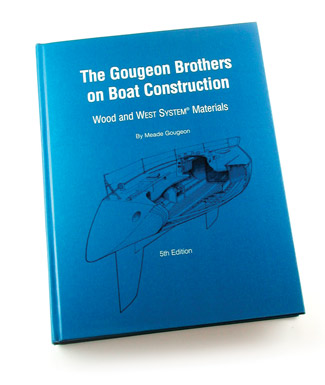
Wood/Epoxy Demystified You can tell a book’s importance and value by where you find it. , The Gougeon Brothers on Boat Construction, is no exception. Tattered, stained copies are found in the shops of virtually every boatbuilder or repairer worth his salt. It’s found in libraries and reference rooms, and within easy reach of a legion of amateur boatbuilders and repairers. My own copies, a 23-year-old, dog-eared fourth edition, and the newly released fifth edition, are tucked in with my prized Oxford Companion to Ships and the Seas, Nigel Calder’s Boatowner’s Mechanical and Electrical Manual, and Chapman’s Piloting, Seamanship & Small Boat Handling. Back in the late 1980s, when I was kicking around Bay City, Michigan, working for the Gougeon Brothers, cooking up ways to sell more epoxy to more folks, the fourth edition had already sold nearly 40,000 copies. With release of the hardbound 5th edition, more than 100,000 copies are now in print—a testament to the value of the information found between its covers. This book is all about building with wood and epoxy. Within its 406 heavily illustrated pages, the reader will find everything from the most fundamental basics of epoxy use, to literate discussions of structural mechanics, to step-by-step instruction on lofting and building your boat—be it a pond-perfect canoe or a globe-girding voyager. Of course, a lot has happened in boatbuilding and adhesive chemistry in the 25 years since the fourth edition was printed. The Gougeon Brothers have learned a great deal—much of it from their own construction projects—and even more by working closely with their West System® brand epoxy customers. What sets this book apart is the author’s on-going experience and research in wood/epoxy construction techniques. Today’s products and technology benefit from more than a decade of NASA-funded research done by the Gougeon Brothers in the use of wood/epoxy construction of high-performance wind-turbine blades in the 1970s and 1980s. Thousands of hours of research resulted in production contracts with early wind-turbine pioneers General Electric, Westinghouse, and Bendix. By the time the Gougeon Brothers closed down their wind-turbine manufacturing facility in the early 1990s, the company had produced more than 4,300 wood/epoxy blades. This impressive combination of laboratory research, mechanical testing and evaluation, and real-world manufacturing experience has laid down an unmatched bedrock of wood/epoxy knowledge and experience, all of it easily accessed within the pages of this book. The Gougeon editorial team has successfully reorganized the new edition into six sections: Fundamentals of Wood /Epoxy Construction, Getting Started, Core Boatbuilding Techniques, First Production Steps, Hull Construction Methods, and Later Production Steps. The first section makes the case for wood’s use as a structural material in combination with epoxy. It’s interesting reading, especially the performance comparisons with other common boatbuilding and repair materials. From there, Getting Started presents five chapters covering safety, tools, materials estimating, and wood selection—good and useful information for hobbyist and professional alike. When you arrive at the section titled Core Boatbuilding Techniques, you hit the mother lode, a section worth the cost of the book by itself. These five chapters, in one fell swoop, spell out several decades’ worth of hard-won construction techniques, short-cuts, and builders’ secrets. From laminating, to glassing, to hardware bonding, this section will be as valuable to the person doing occasional epoxy repairs as it will be to someone building a 60-footer. From this point on, the book discusses, in amazingly simple and easily understood terms, virtually every aspect of epoxy boat construction, including strip-plank, cold-molding, stringer-frame, compounded plywood construction, and more. There’s detail on interior and deck construction, finishing, systems, and teak veneer decking. Not only is there a wealth of written information, but also every page is complemented with detailed photographs and handsome illustrations. One of the highlights of the new edition for me was the photo gallery—gorgeous color photos of Gougeon-influenced boats and products spanning decades. It’s an amazing collection of 66 images that represents the influence of the Gougeon Brothers and this book over the years. It’s a who’s-who gallery illustrating boats with names like Liberty, Tenacious, Antonisa, Rogue Wave, Miss Bud, Scheherazade, Whitehawk, and ,Adagio, not a few of which were built here in Maine. It’s safe to say that there are few books today that have helped as many people fulfill their dreams of building a boat as The Gougeon Brothers on Boat Construction.
—Ted Hugger
Magazine Issue #
Display Title
Book Review: The Gougeon Brothers on Boat Construction
Secondary Title Text
Wood and West System® Materials
Sections






